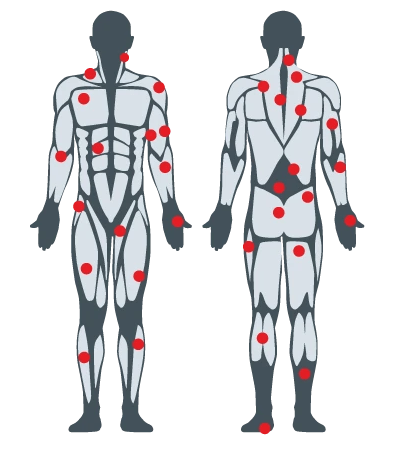What Are Trigger Points?
What Are Trigger Points?
The trigger points are small and tight spots of the muscles that are sensitive and can produce referred pain. Referred pain is described as reflecting pain toward other body parts.
Trigger points can form only in muscles or connective tissue such as fascia. They are also referred to as muscle ‘knots’ or myofascial trigger points.

Trigger points on back muscles
Why Are Trigger Points Important?
They have a huge influence on your muscle and joint health and movement quality. If left untreated, you can experience a loss of muscle strength, range of motion and changed movement patterns.
Example:
- Trigger points in your shoulder muscles can generate pain toward the arm.
- You stop using that arm because of pain.
- Muscles in your arm become weaker and weaker.
- Reduced range of motion in the affected joints.
- After the pain is gone, it is harder to move efficiently as before.
And so on.
Because of that, it is important to understand what trigger points are, what is causing them and how to treat the trigger points.
What Causes Trigger Points?
There are a few theories behind forming of trigger points:
- Repetitive stress
- Trauma
- Sedentary lifestyle/ Poor posture
- Stress
Overuse repetitive injuries – Doing the same movement over and over again can result in excessive stress on muscle fibers and the formation of a few trigger points over a long period.
Sedentary lifestyle – Lack of normal physical activity leads to loss of muscle function such as muscle strength and flexibility. Poor posture is often a result of that kind of lifestyle, as well as a few active trigger points.
Stress – The muscle system is affected by your brain activity in many ways. Stress is contributing factor to increased muscle tension and pain as well.
What does trigger point feel like?
Trigger points are like ‘knots’ in your muscles which can be painful when pressured. An experienced massage therapist should be able to locate and treat them easily.
Trigger Points Symptoms
- tender point
- local or referred pain
- latent pain
- jump sign
- reduced range of motion
- sharp pain
Postural muscles are more likely to form trigger points in general.
What is the jump sign?
The jump sign is the painful response of palpating the trigger point. Involuntary reflexive movement and greater intolerance to even small pressure to trigger point confirm the jump sign. In some cases, it is possible to see muscle contraction with muscle palpation.
Types of Trigger Points
According to the research, there are two different types of trigger points:
- Active – Characterized by tenderness and referred pain on palpation.
- Latent – Painless on palpation, but you can feel them like a tight portion of a muscle.
Trigger Points Map
In theory, trigger points can be found in every single muscle. But, there are a lot of muscles that are prone to forming a trigger point.
- Neck and shoulder muscles
- Lower back muscles
- Gluteus
- Hamstrings
- Calves
With several active trigger points in the body, we are referring to myofascial pain syndrome.

Trigger points map
What Are Myofascial Trigger points?
Myofascial trigger points are a synonym for trigger points. The word myofascial describes the location of the trigger points. Myo is referring to muscle and fascial to the fascia (connective tissue).
How do you release a trigger point?
Apply the pressure on the trigger point and hold for around 60-120s. After that, try to move the muscle slowly up and stretch it a little. The next thing to do is to do some yoga exercises.
What happens when a trigger point is released?
After the release of the trigger point, you will feel a greater tightness release in your muscles and you will move with greater efficiency. Meanwhile, your muscle will receive more blood flow and oxygen and get rid of the other undesirable things that promote inflammation and pain in the trigger point.
Trigger Point Treatment
Some of the most popular treatments for trigger points include:
- Ultrasound therapy
- Stretching
- Yoga
- Dry needling
- Modern acupuncture
- Trigger points massage
- Trigger point injection
What is trigger points massage?
Trigger point massage is a deep tissue massage focused on treating the trigger points or muscle ‘knots’. Applying deep pressure on the active trigger points can be painful during the massage and sometimes a few days after, but it is necessary for their recovery.
Yoga for trigger points
Yoga is a long-term solution for muscle trigger points. Stretching and strength exercises combined with proper breathing techniques will relieve the tension in your muscles easily.
By practicing yoga you keep your body agile and young, as well as reducing the chances of arthritis.
Here you can find reliable yoga for chronic pain relief programs.
Their guidance can help you improve your body health and fight any chronic pain.
Thank you for reading this blog post. You can start exploring other topics here, or follow us on facebook and instagram, if you want to stay updated with our content.
Have a great day!





